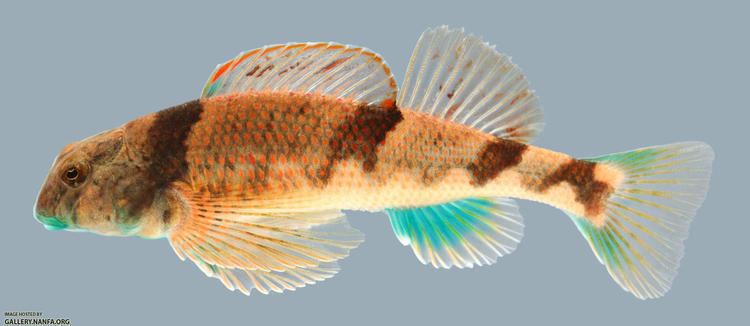Phylum Chordata | Genus Etheostoma Scientific name Etheostoma blennius Rank Species | |
 | ||
Similar Etheostoma, Coosa darter, Blueside darter, Orangefin darter | ||
The blenny darter (Etheostoma blennius) is a poorly known species of fish in the family Percidae, from Alabama and Tennessee that inhabits swift riffles.
Contents
Biology
The blenny darter lives a maximum of two to three years, grows to a maximum of 69 mm standard length, and is sexually mature at one year. It is reproductively active throughout March and April. Spawning occurs over gravel riffles with swift currents. Mature eggs are orange and translucent. The fish are insectivorous, with analyzed gut contents containing Nematocera larvae, more specifically black fly (Simuliidae) and midge (Chironomidae) larvae. Significant numbers of mayfly (Ephemeroptera) and caddisfly (Trichoptera) nymphs were also found.
Characteristics
The blenny darter has a deep and robust anterior body that tapers to a narrow caudal peduncle. The dorsum is olive-brown or tan, with four bold, dark brown to bluish-black saddles. The nape and belly are fully scaled, with the breast and cheek naked. Breeding males show an overall orangish hue, with dull red spots in the center of each upper body scale; the anal fin has eight rays and is bluish-black; caudal and pectoral fins are green with 16 rays; the dorsal fins are reddish-purple with 11-12 rays; the oral and nasal areas are blue, with the rest of head being green. The two known subspecies, E. b. blennius and E. b. sequatchiense, can be differentiated by scalation of the opercle and lateral scale counts.
Conservation
Herbert T. Boschung and Richard L. Mayden (2004) recommend Etheostoma blennius for Special Concern status in Alabama due to its limited distribution. Much of the area in Alabama where the species occurs is proposed for a number of floodwater-retarding dams, and such structures would greatly degrade the remaining habitat.
Distribution
E. blennius is a native southeastern darter found in Alabama and Tennessee, in small to large tributaries of the Tennessee River drainage, more specifically the Buffalo, Duck, and Sequatchie Rivers, and White Oak Creek, Tennessee. The species has a more-limited distribution in Alabama and is restricted to Tennessee River tributaries within the Tennessee Valley of the Highland Rim.
Etymology
Habitat
This darter's typical habitat is deep, fast, clear-water riffles with uncompacted gravel substrates containing minimal or no aquatic vegetation.
Systematics
Brooks M. Burr (1979) used 51 morphological characteristics, which indicated the nearest relative of E. blennius is E. swannanoa (Swannanoa darter) of the E. thalassinum (seagreen darter) group.
Etheostoma blennius belongs to the subgenus Etheostoma that contains the following species:
Etheostoma blennius is further nested within the greenside darter group that contains E. blennioides, E. gutselli, E. inscriptum, E. swannanoa, and E. thalassinum.
